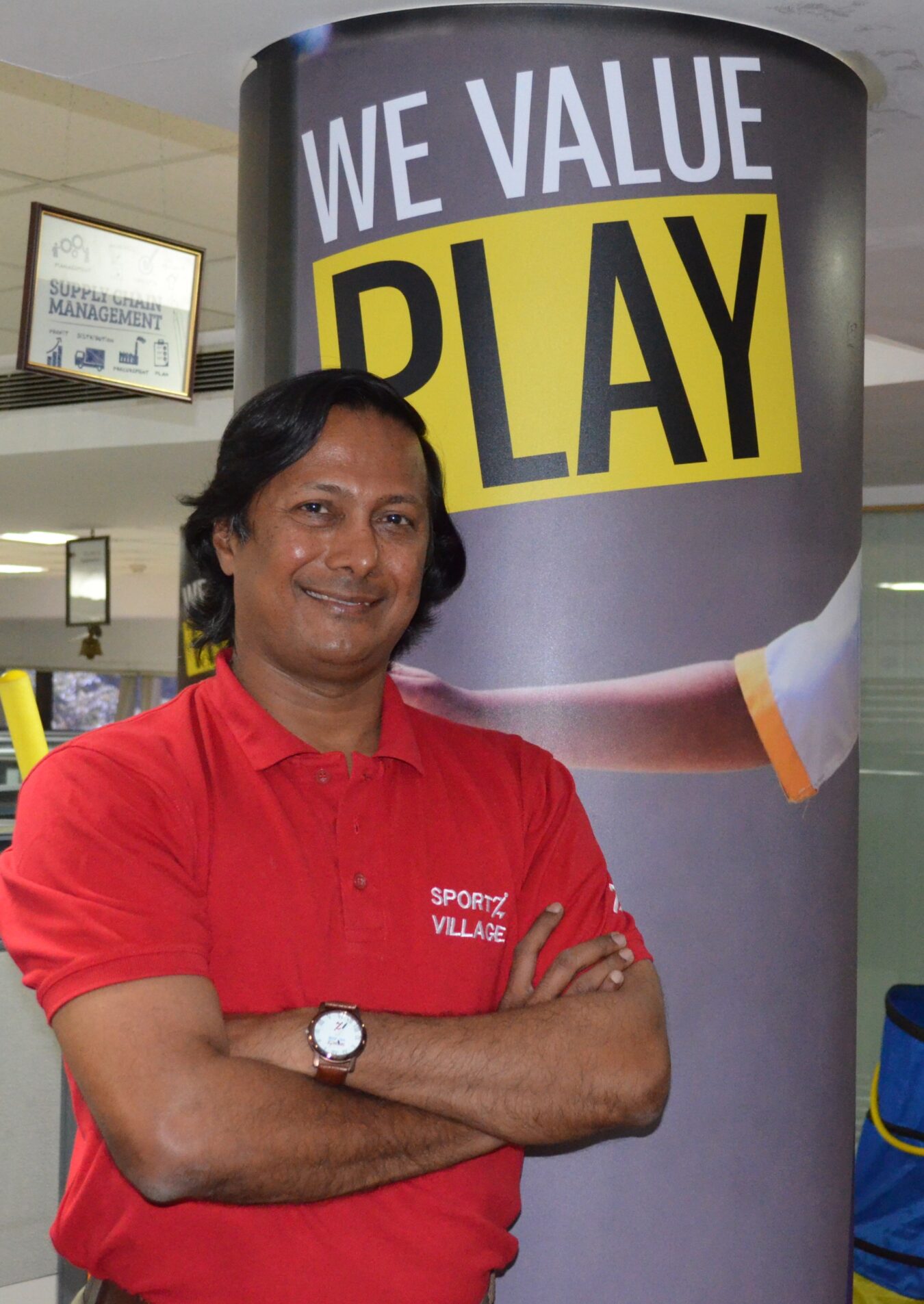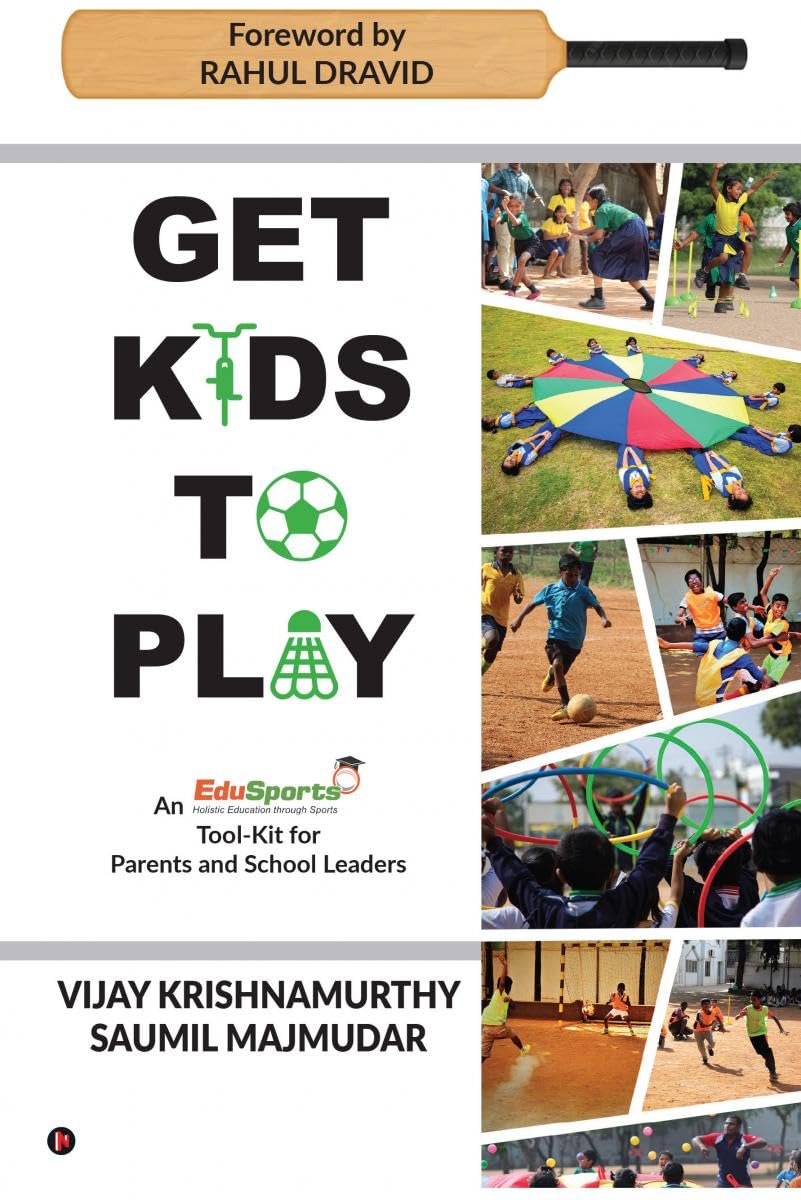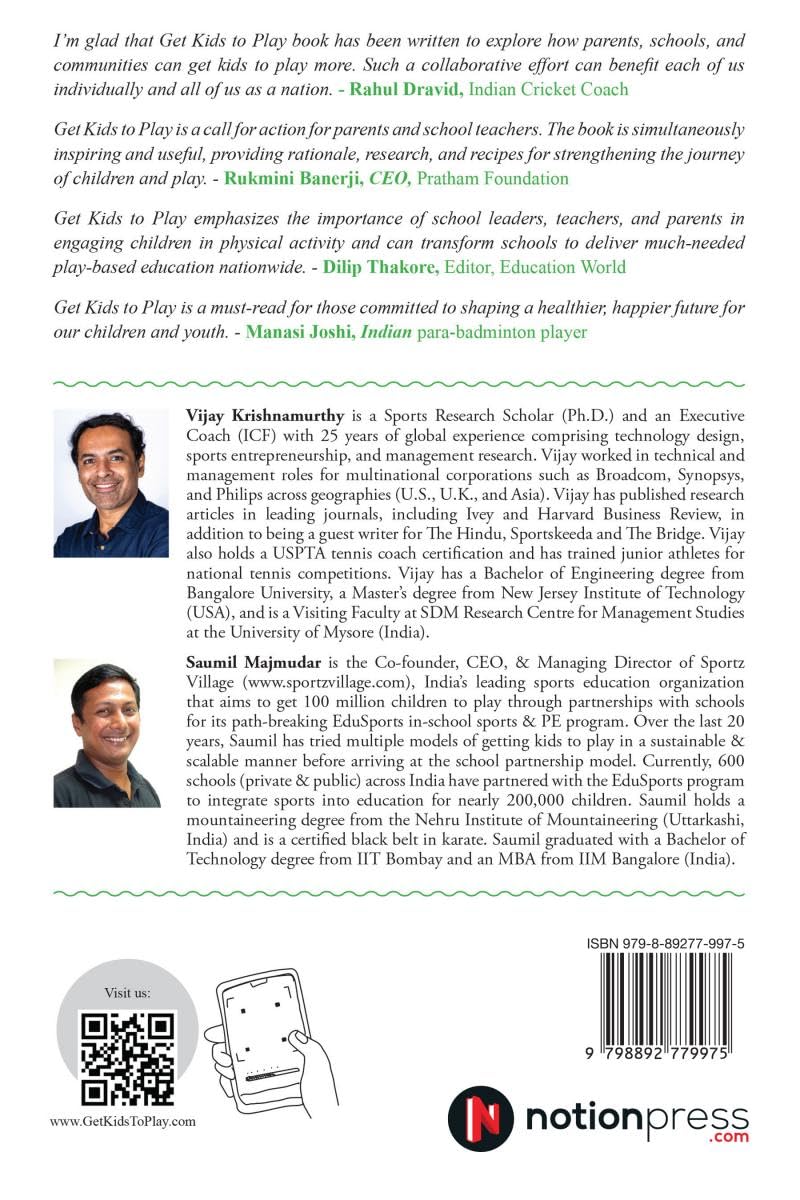Alumni Author: Get Kids to Play – Saumil Majmudar (PGP 1995) and Vijay Krishnamurthy
IIM Bangalore alumnus Saumil Majmudar, alongside his co-author Vijay Krishnamurthy, shares insights into their book “Get Kids to Play” in an exclusive interview. Saumil, drawing from his extensive experience with Sportz Village over the past two decades, sheds light on the challenges parents and school leaders face in encouraging children to play. Combining research-backed strategies with practical solutions, their book offers a comprehensive toolkit aimed at overcoming barriers to play. With a focus on inclusivity and tailored experiences, “Get Kids to Play” aims to revolutionize the way we approach child development through play. As an alumnus of IIMB, Saumil brings a unique perspective to the discussion, emphasizing scalable and sustainable solutions to address this critical aspect of childhood. Through this interview, they hope to inspire a cultural shift towards prioritizing play for children worldwide. Join us as we delve into their journey and the transformative impact of play on children’s lives!


What inspired you to write “Get Kids to Play,” and how does it differ from other resources available on the topic of encouraging children to engage in play?
Saumil: Over the last 20 years of trying to get kids to play through Sportz Village, I found that everyone wants to get kids to play but most people don’t know how to. The typical points at which people just shrug their shoulders and say, “I don’t know what to do next!” are things like “No playgrounds near my home”, “Kid is too tired after the commute to and from school”, “No other kids to play with”, “All academies are too competitive, and my child just wants to have fun”. The narrative around sports and kids at play has been towards winning medals – which accounts for a miniscule % of the entire child population. The remaining (99% and above) want to play but the current context does not enable their playing for fun, freedom, social engagement, forging friendships etc. This book, through the research elements, and the practitioner aspects provides strategies in the form of a toolkit to enable kids of diverse background, skills, and ambitions to play.
Vijay: The inspiration for “Get Kids To Play” comes from the scarcity of resources available at the community level for parents and school leaders. While there are stories of athletes and coaches documented at the elite level, this book, in the form of a toolkit, hopes to solve the challenges at the grassroot level. The research element provides evidence-based identification of the problem, and the practitioner aspect provides strategies for implementation on the ground.


Can you provide some examples of the tools, utilities, and practices outlined in your book that are particularly innovative or effective in addressing the challenges faced by parents and school leaders in promoting play among children?
“Get Kids to Play” resembles a Swiss knife, with a range of solutions for parents and school leaders. The five chapters are Space, Time, Child, Content, and Facilitator. Some utilities and best practices that are outlined in the book are:
- In case of limited space in schools or near homes, use of a structured program/lesson plans that help make the best use of available space.
- In case of lack of sports infrastructure in schools, collaborate with local municipality in close vicinity to share the neighbourhood playground.
- Creating play arenas and sports clubs inside residential complexes for kids to play just for fun.
- Play at home activities for kids who are dis-interested in outdoor sports.
- Ways of handling kids with diverse interest and abilities
- Toolkit to present the value of kids playing to adults who manage budgets for the program.
Similarly, the book mentions several such different problem scenarios and associated solutions that are effective in addressing the challenges.



(Image Courtesy: EduSports by Sportz Village)

(Sample Play Area Use Timetable in an apartment complex with 800 flats):


(Image Courtesy: Anthill Creations)
How do you see your book serving as a practical guide for parents and school leaders, and what specific outcomes or changes do you hope it will facilitate in terms of promoting play for children?
“Get Kids to Play” is written with two critical decision-makers in mind – parents and school leaders. Both groups want to get the kids to play but often struggle with the “How?” and get bogged down with obstacles. Eventually, the problem snowballs into a classic case of “Everybody’s baby is nobody’s baby.” Most often these challenges are Space, Time, Child, Content & Facilitator. Hence, the book contains a range of tools, utilities, and practices to negotiate these obstacles and eventually create a mindset of “It is possible” as against the current mindset of “Everybody’s baby is nobody’s baby” and shrugging of shoulders when an obstacle comes along. When adults speak up for children and play, they very often get stuck with objections about Space, Time etc. Hope that they can point to this book for specific solutions or frameworks.
Could you discuss any personal anecdotes or experiences that motivated you to explore the topic of children’s play in-depth and ultimately led to the writing of this book?
Saumil: Sportz Village started with a casual conversation with a friend back in March 2003. He said, “My 6-year-old son doesn’t play”. As I dug deeper, it turned out that the first problem was one of safe spaces for kids to play. Hence Sportz Village was founded as a venue in HSR Layout in Bangalore in August 2003. As we tried to get more kids to play, we realised that factors like commute, coaching philosophies, diversity of child interests, fitness, skills, absence of data etc came in the way of getting more stakeholders to support the cause of getting kids to play. Over the last 20 years of building Sportz Village, we have tried to get kids to play in various situations and through multiple business models. The book is a result of all the splendid work and experimentation by the team to get 5,00,000 kids to play across 1500 schools over 15 years!
Vijay: Firstly, as a kid (b/w mid-1970s – late 80s), only two things happened in my life – Academics and Sports. I gave sufficient time to both activities, which led me to where I am today as a Sports Researcher. As a parent today, I find the number of challenges regarding play for my children has increased due to several factors ranging from less space to insufficient time. Therefore, the five chapters of our book “Get Kids To Play,” namely Space, Time, Child, Content, and Facilitator, are an accumulation of my experiences as a sports coach, parent, and researcher.
In what ways does your book address the diverse needs and preferences of children when it comes to play, and how do you suggest tailoring play experiences to accommodate these differences?
We have addressed several aspects such as gender, age-appropriate curriculum, children with disability, and coach preparedness toward children’s diverse needs and preferences. The five chapters of the book, include scenarios that highlight the challenges faced, and the EduSports toolkit provides actionable solutions for the respective scenarios. By no means the content of the book is exhaustive for every possible scenario we face at the community level. However, we have addressed the key aspects and plan to continue building relevant content on our website, www.GetKidsToPlay.com.
As an entrepreneur running Sportz Village, how does your firsthand experience in creating play opportunities for children inform the content and recommendations provided in your book?
Saumil: All the toolkits and solutions recommended in the book are based on actual on-ground implementation. The Sportz Village team has executed these tools and solutions on-ground. More than 3 million classes have been conducted across diverse contexts. The feedback for these classes comes back into our system which gives me real-time learnings around how our tools are working (or not). Therefore, the book is called ‘An EduSports Toolkit for Parents and School Leaders’
How does your book incorporate insights from research and academia regarding the importance of play in child development, and how do you translate this knowledge into actionable advice for parents and school leaders?
Vijay: We have developed the book by bringing in our respective domain expertise—research and practice—to the table. From a research perspective, the literature surveyed includes policy documents, global research findings, and organizational case studies in the sports sector. The learnings from each research stream have been blended with the EduSports toolkit to provide actionable solutions to parents and school leaders.
How does your background as an alumni from IIMB influence the approach and perspective you bring to addressing the challenges of promoting play among children in your book “Get Kids to Play,” and how do you believe this unique perspective adds value to the content for readers?
Saumil: As an alumnus from IIMB, I think I bring an approach of solving this problem in a sustainable and scalable manner. At the same time, I make sure that the tools recommended are not just theoretical but are being implemented on the ground in schools across the country as we speak. In addition, there is a deep grounding of research through my co-author, Vijay Krishnamurthy, which helps the readers learn from the similar and related work already done in India and overseas.
This unique perspective is something that I hope will help readers Get Kids to Play!
What do you see as the biggest misconception or misunderstanding that parents and school leaders have about the role of play in child development, and how does your book aim to correct or address this?
The biggest problem is not one of misconception or misunderstanding about the role of play in child development. Everyone acknowledges the role of play in child development; and there is enough research evidence to suggest that physical play positively impacts children’s cognitive development. However, the real problem is that there is no one who has a solution to the various problems that come up as you try and get kids to play regularly. We hope that the book will help people who are looking for solutions. If not, our website www.getkidstoplay.com will provide them a place to post their challenge and we (hopefully) can help as much as possible.
Finally, what do you hope readers will take away from “Get Kids to Play,” and how do you envision the book contributing to a broader cultural shift towards prioritizing and promoting play among children?
It is indeed possible to ‘Get Kids to Play’. That is what readers should take away from the book. If each parent or school leader moves to an “It is possible” shift, we will see the problems being dissected, novel solutions being formulated and various stakeholders coming together to promote play among children. Again, we firmly believe that it is possible to get kids to play—and it is truly worth it!


